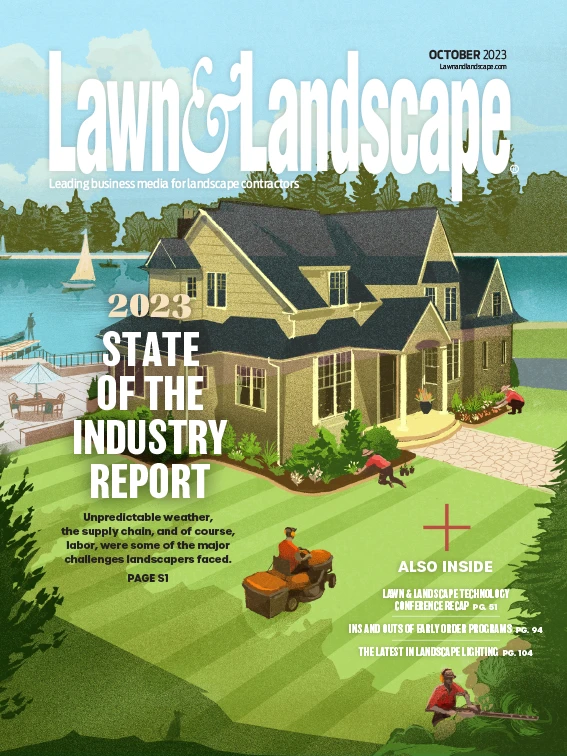
It’s been a crazy year for weather. Maui is burning up. There’s too much rain on the East Coast. There’s a drought in Texas and the upper Midwest, and there are somewhat normal weather patterns on the West Coast. It’s either feast or famine for irrigation contractors. Demand for irrigation service work is at an all-time high while the supply of competent irrigation service technicians seems to be lower than ever. Not surprisingly, the pricing of irrigation service work reflects market conditions more than any other service provided by green industry entrepreneurs.
Today’s market pricing
An irrigation contractor in rural Kansas charges $80 per man-hour portal-to-portal (PTP) or from clock in to clock out for a nine-man-hour day. His technicians need to bill $720 per day (9 MHrs x $80). That calculates to a curb-time rate (man-hours on-site) of $102.86 per man-hour ($720.00 ÷ 7 MHrs). In addition, parts are billed with an average 30-40% margin. His technicians are paid an average of $20 per man-hour.
An irrigation contractor in Kansas City pays his technicians an average of $25 per man-hour and charges $100 per man-hour. His technicians need to bill $900 (9 MHrs x $100) per day for labor for a nine-man-hour day. This translates to $128.57 as a curb-time rate.
Three things should be noted here. First, in both cases, the price to the customer is four times the labor pay amount (4 x $20 = $80 and 4 x $25 = $100). Second, the rural vs. city labor pay rate differential is $5.00 ($25 - $20). Third, the rural vs. city price to the customer differential is $20 ($100 - $80).
A full-service landscape contractor near San Diego pays his service techs an average of $26 per man-hour with a daily billable goal of $882 for a nine-man-hour day. This calculates to almost $100 per man-hour ($882 ÷ 9 MHrs = $98.04).
One irrigation contractor in northern New Jersey bills $125 per man-hour for a nine-man-hour day while another nearby contractor charges $135 per man-hour. Add about $20 to each rate to arrive at the curb-time rate. Both pay their technicians in the vicinity of $30 per man-hour.
Totally off of the charts is a contractor in Jackson, Wyoming, who has to pay his technician over $50 per man-hour and charges clients $150 per man-hour (PTP). His billable amount is roughly three times his labor pay rate. For a nine-man-hour day, this technician needs to bill $1,350 per day for labor.
Yesterday’s 10-year trend
Ten years ago, irrigation service technicians were billed out around the country at an average of roughly $55 per man-hour (PTP). This was for a nine-man-hour day. The average technician was paid approximately $14 to $16 per man-hour. Slowly the billable rate climbed to $65 per man-hour as the labor pay rate increased in the vicinity of $3 +/- $0.50 per man-hour. As you can see, the billable price to labor pay ratio was then, as it is now, roughly 4:1.
It took a while to break through the $65 per man-hour billable rate but it inched up toward $70 per man-hour (PTP). Once COVID-19 spread around the country (and globe) in early 2020, pay as well as billable irrigation service rates blew past the $65 / $70 threshold ceiling to higher ground. As individuals sequestered at home, demand sky-rocketed for irrigation repair services. As a result, technician hourly pay increased as did the billable rates. Billable rates hit $75…then $85…onto $95 per man-hour (PTP). Fast forward to today and contractors everywhere are breaking through the $100 per man-hour barrier.
Benchmarks worth noting
First, there’s a direct correlation between the portal-to-portal billable price that contractors charge their clients and the labor rate paid to irrigation technicians. It’s approximately a 4:1 ratio. Ten years ago, technicians were paid about $15 per man-hour. That rate then began to creep to the $20 per man-hour amount. Not too many years ago, the $25 per man-hour barrier was broken. Today, a really good irrigation service technician who can address any challenge that he or she faces is getting paid in the range of $30 and above per man-hour. Pricing to customers reflects the supply/demand curve. As demand for a service that is in limited supply increases, the price for it increases. Second, labor remuneration tends to decrease as one gets farther from a major metropolitan area. Billable rates reflect this drop and decrease proportionally.
Conclusion
When you apply the time and materials (T&M) pricing model to the irrigation service sector of the green industry, labor pricing mostly reflects the supply/demand curve for technicians and the hourly rate paid them. Flat-rate pricing for irrigation service work also reflects this curve but to a somewhat lesser degree. Too many irrigation service providers are too slow to increase their pricing in fear of losing customers. My clients tell me that they experience little to no pushback when they raise their billable rates. Remember, if a service tech bills 1,500 to 2,000 man-hours per year, a $5 increase per man-hour translates to a $7,500 to $10,000 revenue increase. More importantly, it’s all additional net profit. In crazy times like these, that additional net profit might come in pretty handy.

Explore the October 2023 Issue
Check out more from this issue and find your next story to read.





